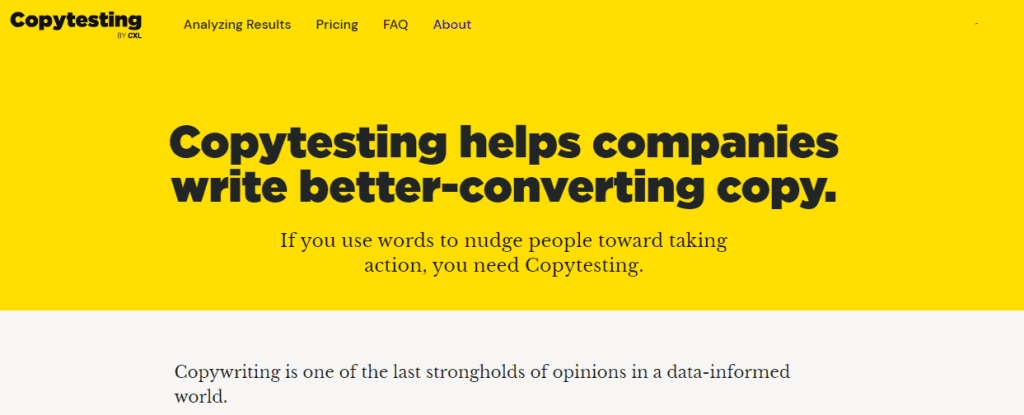Are you using copy testing to ensure that your landing page sales copy is connecting with your target audience and driving conversions?
The history of copy testing dates back to the 1930s when advertisers would use both qualitative and quantitative methods to assess the effectiveness of an advertisement before releasing it to the public.
In the era of one-to-many advertising that used traditional media channels like print, billboards, and television ads, ad executives needed to ensure that sales copy was perfectly optimized when it went to publication. In the digital marketing era, advertisers can serve personalized ads with dynamically generated sales copy to thousands of prospective customers every day, and it’s much easier to make changes to ad copy on the fly.
So is copy testing still necessary?
To answer that, let’s take a deeper dive into copy testing and the role it can play in copy optimization for digital marketers.
[optin-inline id=’dmpl7wrwcq0wrkfgyrxb’]
What is Copy Testing?
Copy testing is a form of market research used by advertisers to evaluate the effectiveness of an ad before publishing that ad for consumption by the public.
Traditionally, copy testing involves the presentation of the ad to a small consumer audience in a context that encourages constructive feedback. During ad copy testing, audiences may be asked questions like:
- Did the ad grab your attention? Did you feel that it was highly noticeable?
- What is the ad’s main message? Is the messaging strong and clear?
- Did you find the ad memorable?
- Did you like or dislike the advertisement? Which parts made you feel good, and which parts missed the mark?
- Did this ad change your perception of the brand? If so, how?
- Would this ad impact your decision to purchase this product? If so, how?
- Do you feel convinced to act by the information presented in this ad?
These questions address the general tone and impact of the ad, it is also possible for copy testing to address more specific aspects of an advertisement, such as the layout or the sales copy itself. Test audiences could be asked to choose which layout of an advertisement they find most visually appealing or to highlight which parts of the sales copy have the most positive impact and identify parts that are off-putting or ineffective.
5 Copy Testing Methods and Alternatives You Should Know
Now that we’ve defined copy testing, let’s take a closer look at how advertisers in both traditional and digital mediums can use copy testing methods and alternatives to improve the impact of their sales copy on target audiences and drive conversions.
Focus Group Copy Testing
Focus groups are the classical method of conducting copy testing. An advertising agency might outsource copy testing to a market research company that would form a focus group based on the target demographic for the ad and start collecting feedback. Feedback in a focus group copy testing scenario is often divided into 4 parts:
- Measuring how consumers perceive the brand or product before seeing the advertisement. This is usually accomplished with self-reported survey questions.
- Presentation of the ad in different contexts, either on its own or together with other advertisements in a more realistic context. Market research companies may use eye-tracking or facial expression recording to measure how audiences respond to the ad itself.
- Measuring how consumers perceive the brand or product after seeing the advertisement.
- Audience profiling questions may be asked to further qualify the information obtained during the copy testing process. Researchers may want to learn about the shopping habits, interests and buying behaviors of the target market to gain better insight into how an advertisement may or may not meet their needs.
Software-Based Copy Testing
Software-based copy testing has emerged as an attractive option for organizations that need to perform copy testing with fast turnaround and results.
Service providers like Copytesting by CXL offer audience research as a service to enterprise organizations looking to collect more feedback about their sales copy before releasing an advertisement to the public.

Here’s how their process works:
- Copytesting draws participants from various panel services and validates their membership in the target demographic before including them in audience testing.
- Copytesting forms a group of testers, usually with 20 participants.
- Each tester grades the clarity and relevance of individual blocks of content within your advertisement on a 5-point scale.
- Copytesting conducts quality control and uses data science to ensure the statistical significance of results before returning them to your organization.
Automated Copy Testing
Software tools like Qualtrics can empower businesses with automated copy testing capabilities.
While Copytesting allows digital marketers to outsource their copy testing needs to a managed focus group, Qualtrics gives organizations the power to design their own copy testing workflows and automatically collect feedback from individuals who have registered to participate in ad testing. Qualtrics supports copy testing for all types of ads, including audio and video, so marketers can manage all of their copy testing from a single platform.
Copy Testing Alternative: Content Experiments
Traditional copy testing methods may have fallen out of favor in the last twenty years, as digital marketers move towards lower-cost methods of assessing the success of their sales copy.
Content experiments are the most important copy testing alternatives that all digital advertising professionals should implement as part of any marketing plan. Content experiments can be used to measure the success of text ads, display ads or landing pages within a target market.
The three main types of content experiments are:
- Split URL Testing: In a split test, marketers split the traffic for a single URL between two different versions of the page to see which one performs better. Split testing works best when the two pages presented are totally different, with different headlines, sales copy, and calls to action. Split testing is useful for identifying a general aesthetic or layout that performs best with target audiences.
- A/B Testing: A/B testing is a narrows version of split testing where digital marketers present two different pages to different audience members, but vary just one aspect of the advertisement. The two pages might be identical, but have a different CTA button, a different image or a different headline. A/B testing is heavily detail-oriented but is ultimately necessary to ensure that landing pages perform at their peak.
- Multivariate (A/B/n) Testing: Multivariate testing is an extension of A/B where marketers test different combinations of ad copy variations by presenting more than two variations of a landing page to target audiences. A marketer could write three headlines and three CTAs for a given page, then combine those to create 9 different page variations. The next step would be to present different versions of the page to nine different segments of visitors to see which ones perform the best.
Copy Testing Alternative: Responsive Google Ads
As a final alternative to copy testing, digital marketers can experiment with responsive Google Ads.
Responsive Google Ads automate multivariate testing for text advertisements delivered through the Google Search Network.
Marketers can write up to 15 headlines and 4 descriptions for a search ad and Google will use machine learning to measure how audiences react to different combinations, eventually optimizing conversions by showing the right variation of the ad to the right audience member at the right time.

Is Copy Testing Still Necessary?
In the past, copy testing was always used to measure the effectiveness of an advertisement before it was released to the public.
In contrast, alternatives like content experiments and responsive ads test variants of your ad in a live context with real members of your target audience.
This has advantages and disadvantages.
On the one hand, members of a focus group may sometimes give positive feedback on an advertisement because they’re agreeable or they don’t want to offend the company or interviewer that’s paying for their opinion. These same people might have a totally different ad experience if they encountered the advertisement outside of a focus group.
On the other hand, copy testing ads with content experiments in a live setting means that digital marketers end up showing non-optimized ads to large swaths of their target audience, which can negatively impact brand image. The upside here is that the live testing environment produces completely reliable results. If the customers are converting, you know for sure that the ad was effective. If prospects are bouncing from your page, your sales copy clearly isn’t connecting and it’s time to go back to the drawing board.
While content experiments are a great way of optimizing display ads and landing pages, digital marketers can still run into trouble when a landing page isn’t working well and it isn’t always clear how to make it perform better. This is where digital marketers can start to benefit from test audience feedback and where software-based or automated copy testing methods can start to play a role.
From our perspective, copy testing is still necessary and is here to stay in some form or the other. Whether it’s creating a focus group or running content experiments, advertisers will always need to measure and refine their sales copy to get the best results from their advertising campaign.
Summary
Digital marketers who wish to see the best possible performance from their display ads, text ads and landing pages need to invest time in copy optimization and integrate some form of copy testing into their digital advertising workflow.
While responsive Google Ads and content experiments are reliable methods here, there’s still a place for traditional copy testing methods in cases when marketers need more specific, qualitative data about how audiences are responding to their ads.
We hope this article gets you excited about using marketing research to test ads and get the best results out of your next digital advertising campaign. Need additional insight into copy testing for your ad campaigns? Book an intro call with our team of PPC specialists.
-
CEO Garrett Mehrguth
Did you enjoy this article?
Share it with someone!



